
- Red Search
- Resources
- Blogging Statistics
Blogging Statistics 2025: Growth, Trends, Insights
-
 Daniel Law
Daniel Law
From their humble beginnings as digital diaries, blogs redefine how brands build personal connections with potential customers. With over 9 million blogs posted daily, blogging is far from getting left behind in the vast digital realm.
The blogging industry is set to grow by $417.85 billion between 2021-2025. Beyond trends, blogging is a digital powerhouse that continues to shape the online landscape.
Uncover the growth projections, latest trends, and insightful statistics in the blogging sphere to scale your brand’s online presence and drive meaningful engagements to infinite audiences.
The Growth of Blogging: Key Statistics
During the primitive days of blogging, blogs served as online diaries, letting you share anything. Once a niche hobby, it has evolved into a global sensation that turned the lifeblood of the internet. Whether you’re looking for answers or products, blog posts have it all.
As 6 in 10 people regularly browse the internet globally, blogging fuels countless businesses with online content to expand their visibility. In 2025, blogging shifts to crafting impactful, relevant, engaging content that matters for your brand to stand out in the vast web space.
Global Blogging Landscape
On a ballpark estimate, the internet hosts around 600 million blogs out of 1.9 billion websites globally. This staggering figure translates to blogs’ sheer breadth covering a third of the web.
In perspective, websites spawn an average of 7.5 million blog posts daily or over 2.7 billion content pieces annually. While that’s a mind-bending digit, it can still go up as not all platforms publicly share their data or websites become inactive.
With this daily surge of blogs, about 26% of 207 million creators worldwide are bloggers. That’s roughly 54 million bloggers globally crafting a plethora of blog posts. In 2025, blogging will skyrocket as AI-powered tools automate content and site creation to scale brand visibility.
Rise of Business Blogging
As Google keeps tightening the screws on search engine algorithms, online businesses are optimising blogs to stand out in the cyberspace. In B2B marketing, about 84% of B2B marketers use blogs to circulate content, building their brands’ reputation and leadership within an industry.
As businesses don’t purchase like regular people do, about 71% of B2B buyers read blog posts before purchasing. That suggests why crafting top-tier, industry-relevant blogs can help you draw companies as customers and build robust relationships.
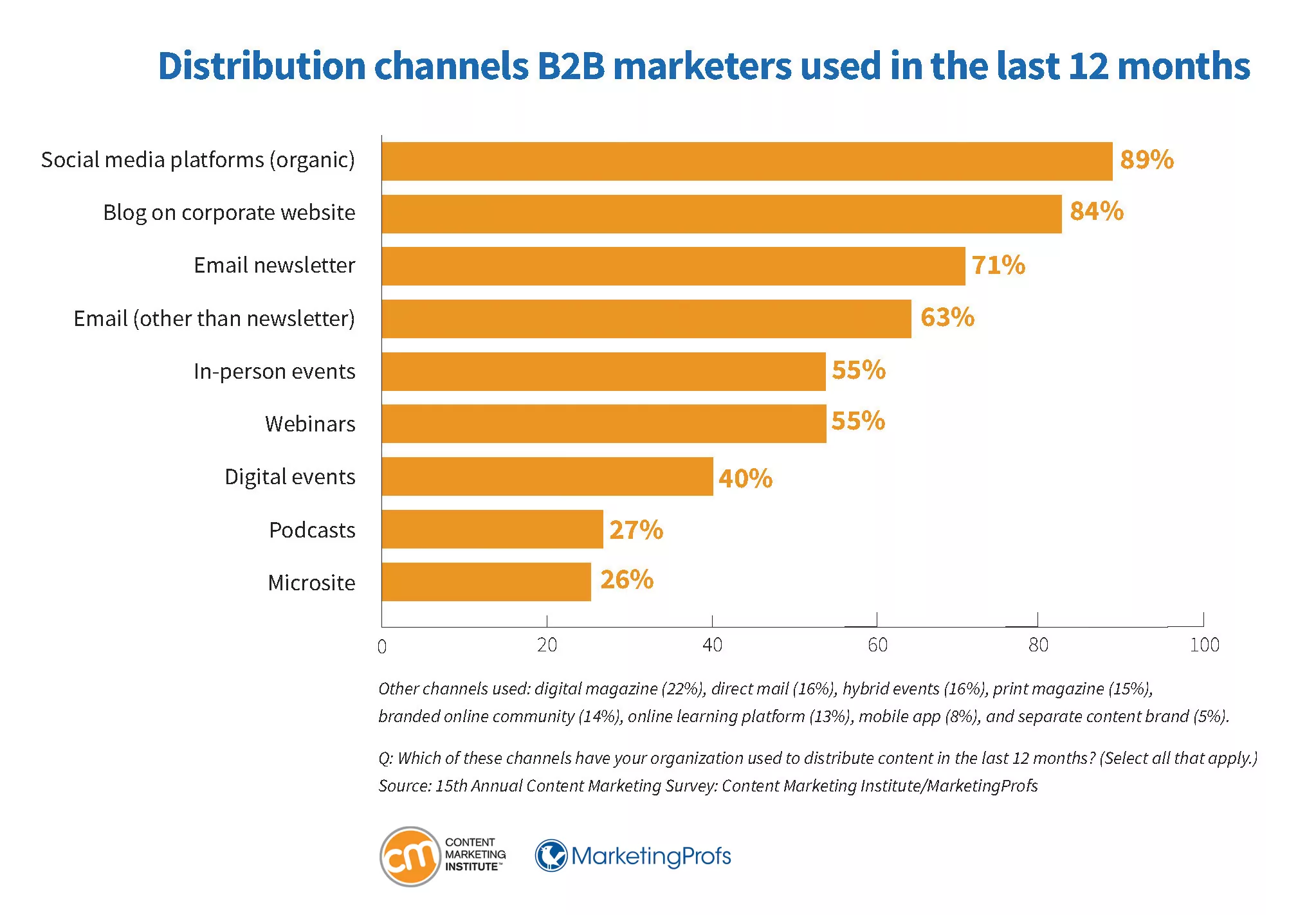
Source: CMI
Conversely, about 76% of B2C marketers use blogs to attract and engage individual customers (refer to the chart). Securing your blog active generates 97% inbound links, allowing indefinite clients to discover your brand from other sites.
These augmented inbound links can scale your site’s authority and ranking, consistently driving organic traffic, leads, and sales. While that’s promising, fetching high inbound links demands superior blog content that other websites find valuable enough to link from your site.
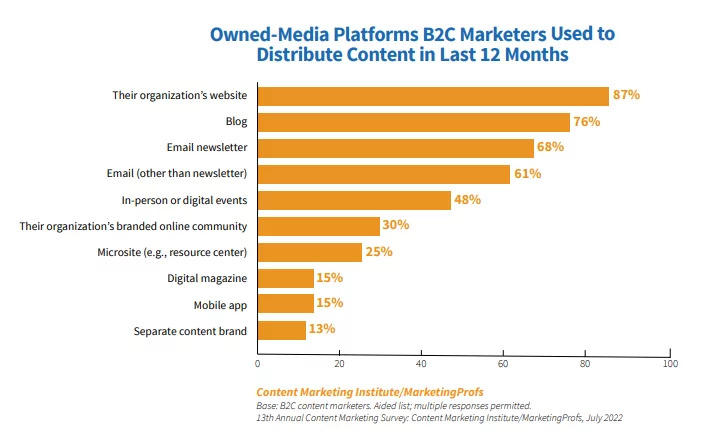
Source: CMI
Blog Traffic Trends
Blogging trends suggest that about 83% of internet users (4.4 billion) read blog posts. That’s identical to 8 in 10 potential customers browsing blogs to guide them in using or buying certain products. However, 75% of search engine users don’t look beyond SERPs’ first page.
Can blogs turn website scanners into committed readers or buyers? According to Hubspot, businesses that blog grow 126% more leads than those without blogs. Additionally, active business blogs get 55% more website traffic than those disregarding blogging.
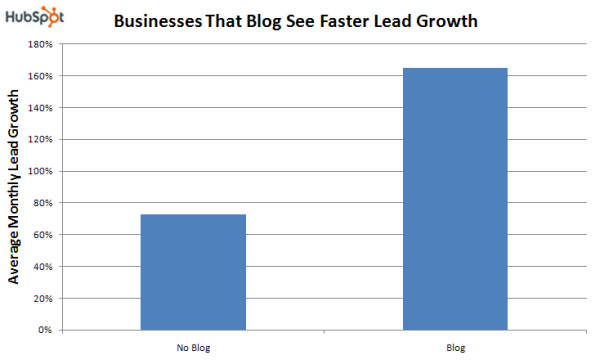
Source: Hubspot
Since 68% of young individuals prefer mobile phones to read blogs, blog platforms are becoming more smartphone-friendly. Data show that 35% of readers frequently skim blog articles, with most only spending 52 seconds. If your blog’s reading time is over 7 minutes, this can dwindle engagement with most users.
Blogging Content Trends: What’s Popular in 2025 and Beyond
As Google prefers updated, relevant content, consistent blog posting is key to standing out in search engines. While fresh content will likely rank high, blog quality remains the core factor that fully engages and compels readers. Let’s explore the trends shaping blogging content.
Long-Form Content Dominance
Although 75% of users prefer blog content under 1,000 words, long-form articles (exceeding 1,200 words) outperform their shorter counterparts. Backlinko reveals that long-form content gets 77.2% more shares than short articles, though it declines when exceeding 2,000 words.
When readers take more time reading your content, it signals search engines that your blog is valuable and engaging. Google’s search algorithm favours these in-depth, comprehensive articles, catapulting your blog’s rankings, organic traffic, and conversions.
Google’s first page results are 1,447 words long on average. Meanwhile, Semrush suggests that blog posts within 1,500-2,500 words offer enough insightful topics to yield higher organic traffic.
An in-depth study also reports that long-form content has a 30% higher conversion rate, yielding more clicks, signups, or order placements. This trend implies detailed content fosters trust and encourages user actions.
Visuals and Multimedia Integration
When creating engaging content, multimedia elements best capture readers’ attention. Visuals also make it easier to read and digest, whether you’re looking for instructions, product details, or numerical projections.
Blog articles embedded with images get 94% more views than text-only posts. Further statistics corroborate this, as posts with visuals like charts, graphs, photos, and colour designs improve by 80%. Meanwhile, about 87% of consumers say video quality impacts their trust in brands.
Among popular blog types, 25% of bloggers consider infographics one of the most effective content formats that appeal to and inform users. While everybody’s not a design whiz, intertwining visuals and multimedia in blogs is your edge to stay ahead of the curve in 2025.
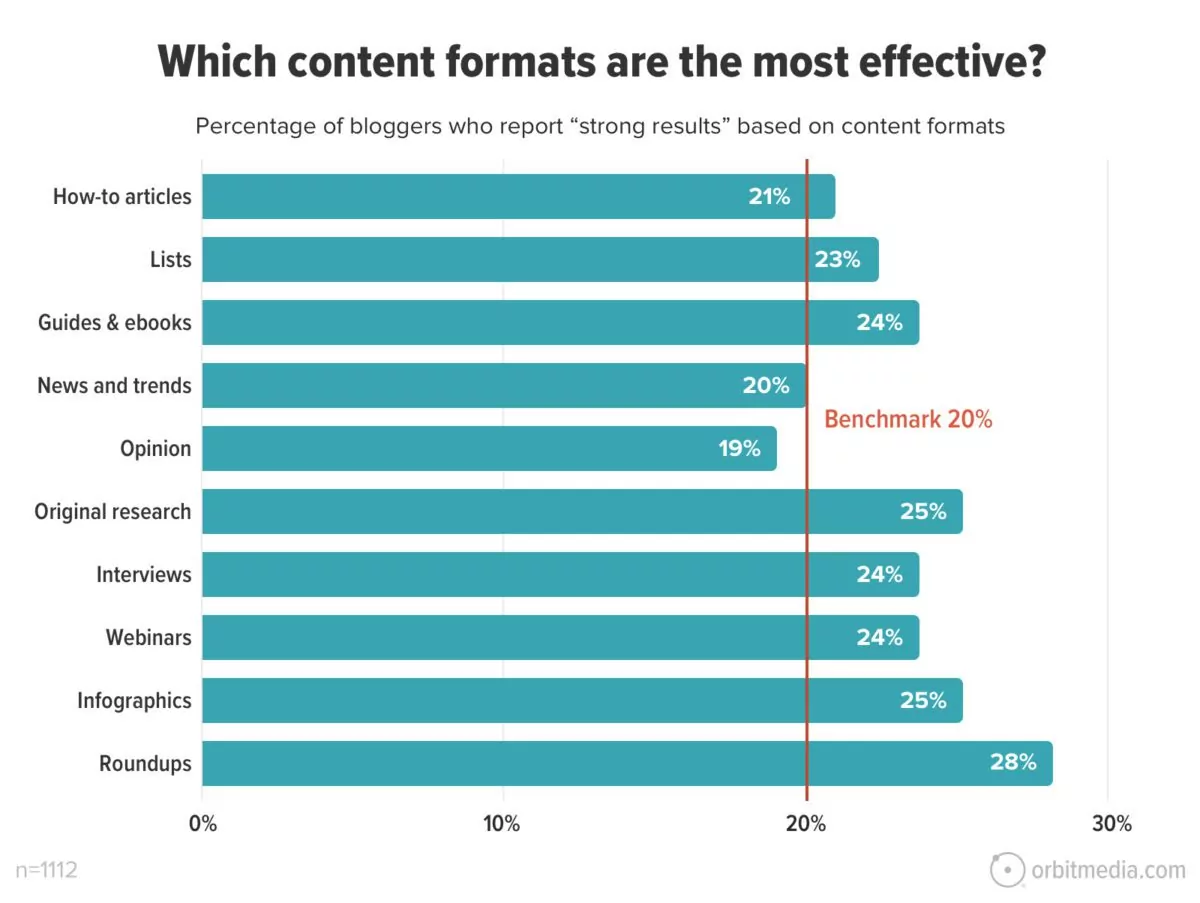
Source: Orbit Media
Niche Blogging Growth
With millions of blogs competing for attention, niche blogging is gaining traction to stand out from the vast content universe. By delving deep into a specific niche, you’re building expertise in specialised topics that differentiate your content from general blogs.
In 2025, bloggers who focus on hyper-specific topics will help them foster deeper engagement and drive revenues. For instance, top niches reliant on Google, like the medical, travel, design, finance, and fashion sectors, are ripe for niche exploration.
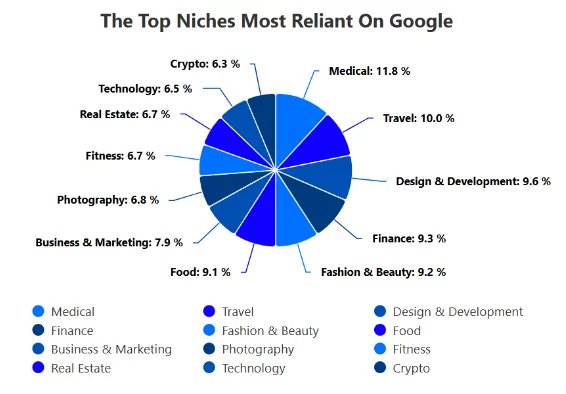
Source: 100+ Niche Website Statistics, Benefits, Metrics, & Challenges
Recent data shows that 72% of bloggers attribute their success to focusing on a distinct niche. With in-depth topics, 67% of consumers trust niche websites for product recommendations.
This high trust is often more attractive to users and advertisers, explaining why niche blogs can drive your revenue from product sales, sponsored posts, and affiliate marketing.
Blogging for SEO: Why Blogs Are Still Key to Ranking
As search engine algorithms focus on content quality and relevance, standing out in the digital space is tougher than ever. By crafting valuable, engaging content that resonates with your readers, you can establish a robust online presence and reach the top of search results.
Besides content quality, blogs prioritising relevant keywords, links, and user engagement are likely to rank high in search results and retain more visitors.
Explore why blogs are your competitive advantage in outperforming other sites in the digital sphere.
Impacts of Blogs on Organic Traffic
Can blogs augment your site’s organic traffic? While blogs’ primary goal is to attract readers, achieving this is virtually impossible without search demands. Streamlined, user-relevant blogs that solve consumers’ pain points are key to scaling your site’s visitors.
Every time users search, Google filters through millions of web pages stored in its index. The great news is that websites with active blogs have 434% indexed pages, giving your site more opportunity to rank high.
Semrush reveals that the top-ranking results have a 22.4% CTR. That’s almost a quarter of Google users clicking on the first organic result. As your site moves away from the top result, for example, to the 10th position, your site only gets a 2.3% CTR.
Unless your blog ranks in the top 10, your blog posts aren’t attracting much organic traffic. In other words, you can only notably attract organic traffic if you generate authentic blogs that stand out and matter to your target audiences.
The Role of Keywords and Backlinks
Strategically embedding relevant keywords enhances your blog’s visibility. For instance, using long-tail keywords (3-4 word phrases) that your potential customers might use can drive high engagement rates since they often closely match user intent.
Conducting keyword research using Google Keyword Planner, Ahrefs, or Semrush can help you find relevant terms with high search volume and low competition. While keywords attract more traffic, they must have a conversational tone to engage readers longer.
As users stay longer reading your blog, this signals search engines that your content is valuable, relevant, and satisfies user intent. This high user engagement can boost your search rankings, attracting other websites to use your blog as reference material through backlinks.
Backlinks serve as digital confidence that other websites place on your blogs. The more backlinks you get, the higher your chance of standing out in SERPs.
Backlinko’s study reveals that results ranking first have 3.8 times more backlinks than positions at 2 to 10.
Even though Google diversifies its algorithm, this figure strongly suggests that backlinks remain a critical ranking signal. While content quality matters most, relevant keywords and backlinks are the nuances that help you stay steps ahead of the blogging landscape in 2025.
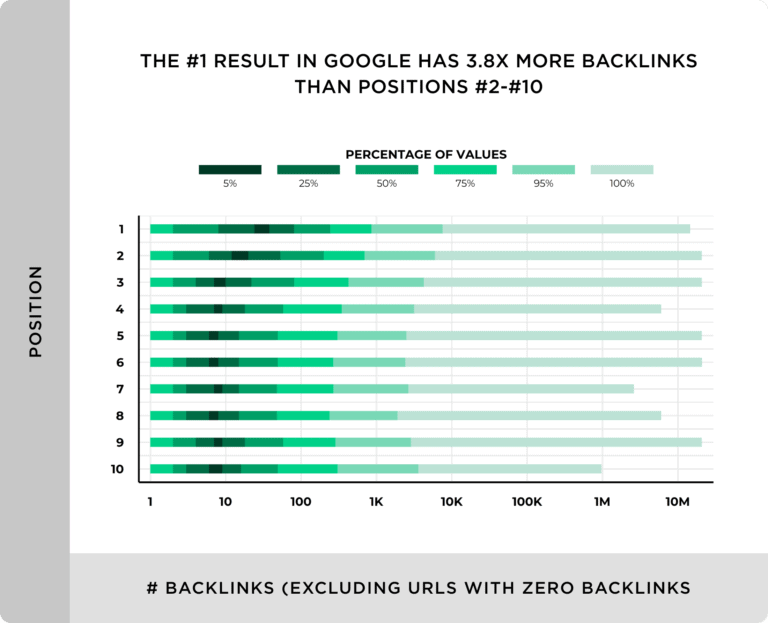
Source: Backlinko
Core Web Vitals and Blog Performance
Core Web Vitals are a set of metrics Google uses to assess your webpage’s loading speed, responsiveness, and visual stability. Here are some steps to optimise these metrics to enhance your blog’s SEO and performance:
- Prioritise Page Speed: Optimise your blog images and reduce HTTP requests to improve loading times by 2.5 seconds or less to ensure a good user experience.
- Ensure Mobile-Friendliness: Design your blog for seamless viewing on various devices, such as smartphones or tablets, while ensuring it scrolls, moves, and responds swiftly to user interactions.
- Enhance Visual Stability: Avoid overlaying content and ensure smooth page transitions with appropriately sized content for a positive user experience.
Google uses page experience as a ranking signal, so focusing on fast-loading pages can help your blogs rank higher in search results. Securing mobile-optimised blog pages is vital to drive organic traffic and leads, as mobile devices account for over half of global web traffic.
AI-Generated Content in Blogging: Opportunities & Challenges
With the many nuances in crafting top-notch blogs, artificial intelligence (AI) is bridging the gap to automate content creation. Besides generating content fast, AI-powered tools can analyse audience data and personalise user experience, which is critical to adapt to changing consumer behaviour.
While AI is a powerful tool, it is best to use it as an assistant rather than relying solely on content production. Despite these advancements, human, authentic content remains the core trend in 2025.
Let’s further explore how AI is reshaping the future of blog creation.
AI-Driven Blog Creation
Semrush reports that marketers using AI spend less than an hour writing a long-form blog post. AI tools can help you brainstorm ideas, providing fresh angles you might not have considered otherwise. These can also help you tailor content based on your brand voice, quality, and style.
According to Authority Hackers, 85.1% of marketers use AI tools for blog writing (refer to the graph). Similar data shows that ChatGPT reigns supreme among all AI tools, with 89.3% of AI adopters using it. Other free or paid tools are swarming the AI-content automation market.
Besides blog or copywriting, AI tools are adept at generating keyword searches to streamline your content, boosting visibility and traffic. However, using them with human expertise is important to create accurate, engaging content aligned with your brand’s goals.
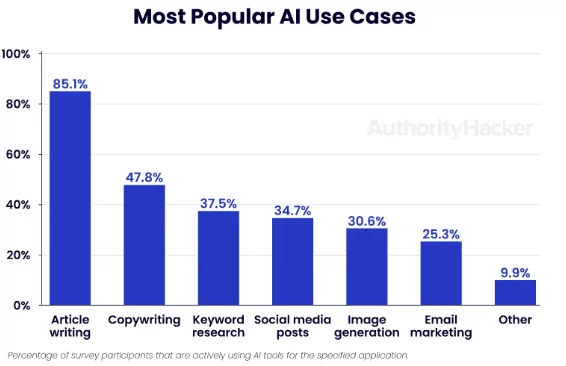
Source: AI Survey: How 3,812 Digital Marketers Are Using AI in 2024
Statistics on AI-Generated Blog Use
With the tense competition in the digital space, AI tools will be vital to any content strategy in 2025. More than half of businesses use AI content tools, and around 47% of companies see a moderate improvement in content quality after leveraging AI (breakdown in the graph).
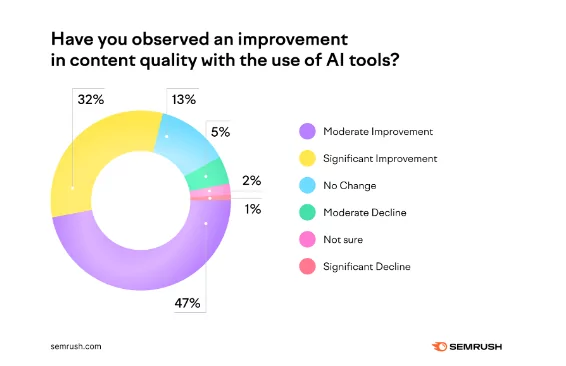
Source: 96 Content Marketing Statistics You Need to Know for 2024
Semrush notes that 68% of businesses reported increased content marketing ROI with AI. This strongly implies that AI applications can streamline high-quality content that delivers results.
While over two-thirds (76%) of companies think AI augments content quality, AI-generated posts may take 2-3 months to rank. With that, you can explore other AI potentials in securing relevant keywords, high-quality backlinks, and impactful visuals to top the search engines.
Quality and Ethical Concerns
AI-generated blogs can perform well but have their fair share of downfalls. While AI polishes grammar and coherence, it often needs more nuance, depth, and creativity of human-written content. AI tools may also mimic existing content, potentially harming your brand’s reputation.
At worst, it can provide inaccurate information, declining reader trust in your blogs. Dispersing factually incorrect data can be harmful, especially in the medical, finance, and technology verticals. Google highly scrutinises data authenticity to assess your site’s authority and trust.
This firmly suggests why only 32.5% of users trust AI-generated results. As AI technologies patch these shortcomings, about 72.6% of users raise concerns over AI’s similarity to human writing. While accuracy is a concern, Google’s stance is to evaluate content based on quality.
Mitigating these ethical concerns requires human oversight to ensure accurate, transparent outputs that align with your brand’s intended message. Another way to sidestep its pitfalls is to attribute sources properly and use the tools to spark ideas but not entirely write everything.
Blogging Statistics by Industry: A Sector-Wise Breakdown
Although blogging is challenging for most businesses, it remains the most popular content format for scaling brand visibility and authority. Let’s understand by the numbers which industries dominate the blogging landscape and how they measure their success.
Top Industries Leveraging Blogging
Whenever a business posts a blog, it informs Google that its site is active and, depending on diverse ranking factors, ranks it higher on SERPs. Daily blog posting increases a brand’s site search traffic, generating more visibility, leads, and sales.
As consumers use search engines 20% more year-over-year, each industry has the edge to perform well in the digital realm. In 2022, search traffic for the electronics, beauty, media, and food industries spiked substantially, reaching millions of users. However, traffic to the fashion, service, and technology sectors has dropped significantly.
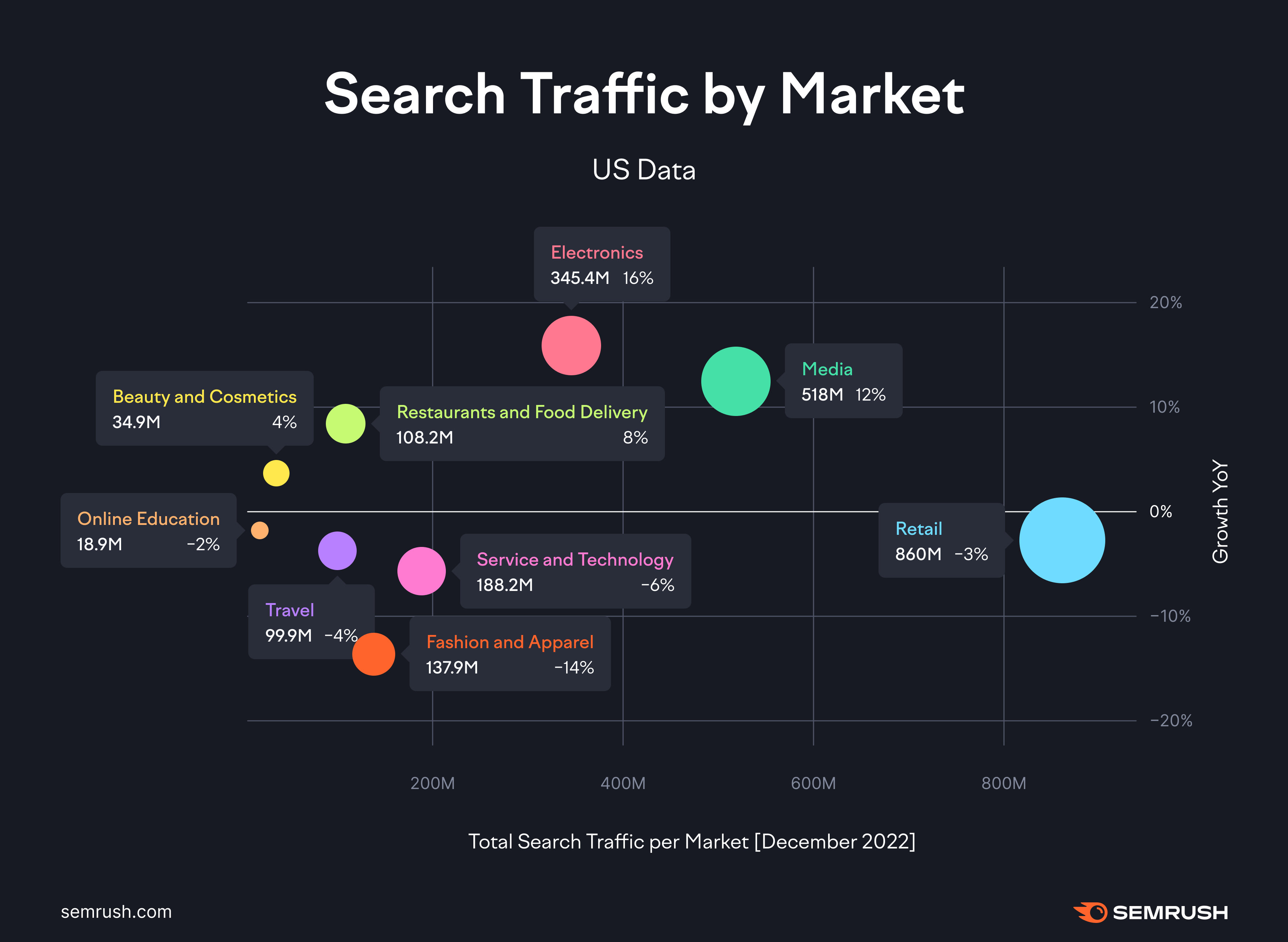
Source: The State of Search 2023
One step to driving search traffic is for companies to craft impactful blogs on industry trends, product launches, and relevant issues. These blogs engage readers to read, share, and look for them online. In other words, blogs that spark curiosity and interest drive traffic exponentially.
While traffic for various industries shifts depending on users’ search demands, leveraging blogs is key to keeping your site active and discoverable by an infinite audience in 2025.
Performance Metrics Across Industries
What key metrics can tell your blog performs well? Across various niches, over one-third (38.64%) of bloggers measure success based on page visits. Securing high click-through rates means your blogs are alluring, even for users with short attention spans or often skim posts.
Almost one-fifth of bloggers (18.93%) consider successful content with many shares. This high engagement can signal search engines that your blogs are relevant and worth sharing, allowing them to rank high in SERPs. Only 15% measure success based on email subscriptions.
Additionally, only 7.67% of bloggers believe they are successful when they can compel users to purchase. With professionally-written blogs getting at least 100,000 visitors annually, this can turn your website from a personal journal to a business that generates revenue.
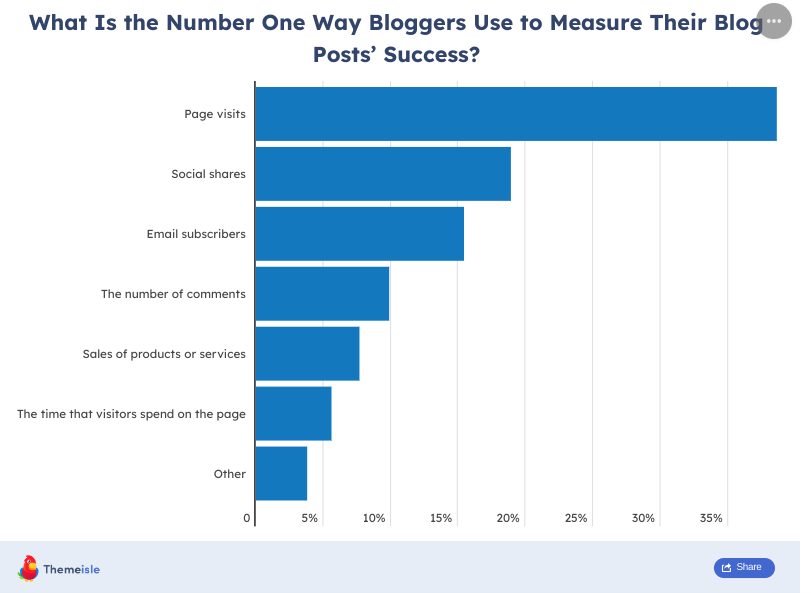
Source: 20+ Blogging Statistics for 2024: Trends & Insights
Blogging Tools and Platforms in 2025
As content automation floods the web space each second, finding the right platforms and tools can help you stay ahead in the blogging landscape. With the evolving user preferences and appetite for authentic, relatable content, bloggers are entering a new era of digital storytelling.
Top Blogging Platforms
WordPress and Tumblr are two behemoth blogging platforms on the Internet. About 490 million users visit WordPress-powered sites, generating an undisputed 20 billion page views monthly.
Next on the list is Tumblr, which has 198 million active readers each month. Another popular platform for hosting blogs is Medium, catering to around 100 million blog readers monthly. Lastly, about 37.6 million readers visit Blogger.com every month.
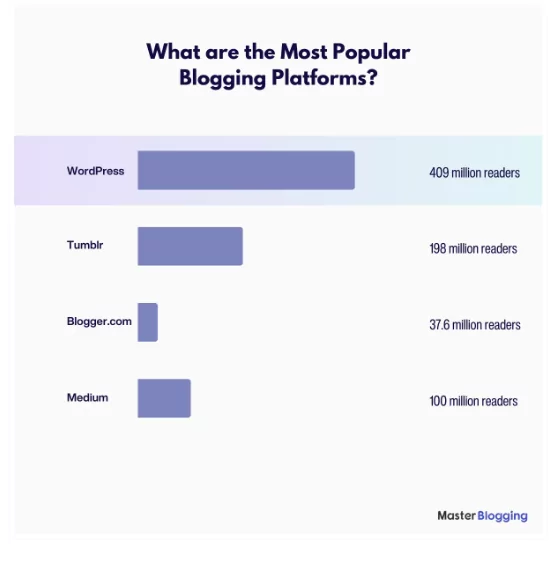
Source: How Many People Read Blogs? (2024 Readership Stats) – Master Blogging
Substack prominently empowers individual bloggers to reach targeted audience profiles through newsletters and exclusive content among emerging platforms.
Meanwhile, Ghost is a minimalist blog hosting platform that helps you grow your business through content.
Essential Blogging Tools
In 2025, you need a robust toolkit to streamline and elevate your content to stand out in the content sea.
Here are some essential tools to convert your ideation into a top-notch blog.
Content Research Tools
- AI-Powered Assistant: AI tools like ChatGPT, Jasper.ai, and Copy.ai can help you generate unique ideas, write drafts, and optimise blogs for search engines.
- Social Listening Tools: BuzzSumo, AnswerThePublic, and Google Trends can help you scour trending questions or topics to create highly relevant and engaging content.
- Keyword Research Tools: Ahrefs and Semrush are essential for identifying relevant keywords and understanding user intent to streamline content.
Content Editing Tools
- Grammarly: This popular tool can help you polish your grammar, punctuation, and spelling, with advanced options to elevate your writing style, tone, and readability.
- Hemingway Editor: It simplifies complex concepts and highlights readability issues to help you generate more concise and impactful content.
- ProWriting Aid: This suite of tools provides actionable advice on crafting, polishing, and elevating your writing, often offering in-depth writing reports to cover weak points.
SEO Optimisation Tools
- Yoast SEO: This comprehensive WordPress plugin provides real-time SEO analysis and suggestions for your content to top search engine rankings.
- Google Search Console: This free tool provides valuable insight into how Google views your site, helping you refine your SEO strategies.
Trends Shaping the Future of Blogging
As consumer behaviour evolves, so do the content formats. With technological advancements in content creation, blogging holds immense potential for creators and businesses to unlock.
Let’s glimpse some key predictions reshaping the blogging sphere in 2025.
Interactive Blog Content
As 43% of consumers skim blog articles, you only have a few seconds before users disengage and jump to the next site. Modern readers crave interactions, not just plain text, to stay glued to your blog posts and compel them to action.
For instance, incorporating elements like quizzes, polls, and surveys can make your content engaging and participatory, enhancing user experience. Blog posts are increasingly leaning over interactive infographics that provide immediate value to readers looking for statistical insights.
These interactive content formats encourage readers to participate, lowering bounce rates. Around 79% of marketers see interactive content improves message retention among users.
With that, expect more sophisticated interactive experiences in 2025. Incorporating immersive experiences into your blogs is your competitive edge to drive your site’s visibility and traffic.
AI-Powered Personalisation
AI algorithms analyse user data, including browser history and past interactions, to create a detailed user profile. This unique user profile allows AI to personalise content recommendations.
For example, if users spend more time reading about gadgets, AI algorithms prioritise similar content in their feeds. This real-time personalisation ensures relevant content aligns with the users’ interests and preferences. Bloggers can benefit from this as AI can redirect their content to more specific, highly interested audience profiles.
Sustainability in Blogging
Content increasingly promotes eco-conscious practices as bloggers recognise their influence on consumer habits and environmental impacts. For instance, blogs feature more brands and products committed to sustainability.
Whether your blogs revolve around topics like zero-waste living or fashion ethics, this provides tips and advice for readers to adopt greener habits. Not only in writing, but bloggers are reducing digital clutter to cut energy use associated with excessive data storage and transfer.
Final Thoughts
With 600 million existing blogs, content automation will likely spawn more and surpass the billion mark. Understanding these key blogging statistics can help you adapt to shifting trends and stand out in the content universe.
While content optimisation brings substantial results, building a top-quality blog that provides genuine value to search engines and audiences takes time and effort. At Red Search, we help businesses create data-driven, high-performing SEO blogs that generate high quality organic traffic.
Frequently Asked Questions
1. Why is blogging still important in 2025?
With searches up 20% year over year, blogging remains a crucial marketing tool for building brand authority and attracting countless potential clients. Consistent, high-quality blogging positions your brand as an industry expert, helping you stand out in search results and boosting user traffic, loyalty, and trust.
2. What’s the average ROI of blogging for businesses?
Companies that maintain blogs generate 67% more leads than those who don’t blog. These augmented leads can drive traffic from high-quality prospects to increase your business’ sales. Data corroborates that brands prioritising blogs have 13 times more ROI than brands that don’t.
3. How does AI influence blogging trends?
AI tools can identify trending topics, generate drafts, and optimise content for search engines. This rapid content automation allows bloggers to focus more on strategic tasks to ensure blogs remain relevant and engaging.
However, AI can provide inaccurate data or duplicated content without human proofreading or fact-checking, harming your brand’s reputation.
4. What type of blog content performs best?
In 2025, long-form content providing in-depth insights will perform better as it can satisfy user queries than shorter posts. Meanwhile, blogs embedded with visuals and interactive content perform best, considering modern users have short attention spans and crave meaningful, immersive interactions and engagements.
Check out more related statistics through our posts below:
Written by:






